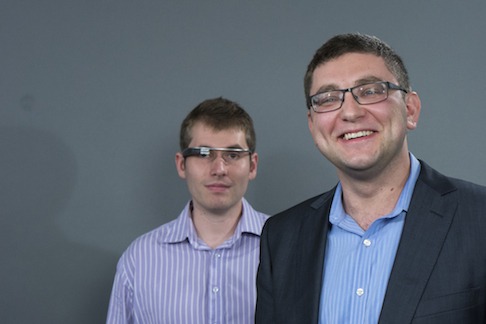Wisconsin School of Business Finance Assistant Professor Michael Gofman was looking for a solution to a problem many educators face: how to improve feedback to students. In February 2014, he did something revolutionary—he purchased a pair of Google Glass with Innovation Funds for use in his curriculum through the Google Glass Explorer Program.
“Instead of marking the paper and posting the solution, we can record personalized videos for each student,” says Gofman. “We’re not just showing their grade and what they did wrong, but how they can improve in the future. The technology was the perfect fit for the problem.”
After only one semester of using the technology, student evaluation scores that measure the quality of feedback in Gofman’s corporate finance course jumped to 4.69 (on a scale from one to five, five being the highest)—an increase of 38 percent from the year before and 22 percent higher than the average for all business courses during the Spring 2014 semester.
Gofman is among the first university professors in the world to use Google Glass for academic feedback for students.
Last spring, his teaching assistant for the course, Adam Spencer, began using it for the midterm exam. By using the device, Spencer was able to give more nuanced and detailed feedback to each student, touching on mistakes, what they did well, and how to build on what they’ve learned.

Spencer followed the same process with each assignment, exam, or group project for the rest of the semester. First, he would grade the work, then turn on Google Glass and spend 30 seconds to nine minutes reviewing the assignment or exam and providing detailed feedback. Then Spencer would simply upload the video file from Google Glass to the course website so students could access their feedback video at their convenience.
“Using Google Glass to deliver feedback helps students understand the material better,” Gofman says. “What’s important to me is that my students understand the takeaways and develop strong skills that will allow them to succeed in the future, and this new feedback approach is improving the learning experience.”
Both Gofman and Spencer were impressed with the student response to the videos. Gavin Hartzog (BBA ’15, MS in Finance ’16), who plays on the Wisconsin Badgers hockey team, says the videos were a convenient way for him to get customized feedback on the go, whether he was at home or traveling for a game.

“I think the best way to learn through mistakes is by seeing someone explain it to you,” says Hartzog. “I continued to replay Google Glass videos so I could identify my strengths and weaknesses to better prepare for the next exam. I think it helped tremendously.”
The use of Google Glass for academic feedback is one of the many ways the Wisconsin School of Business is leading the way in educational innovation.
“There’s a long tradition in higher education to give students homework, quizzes and exams, and many of our faculty have always wondered, ‘how do I make assessments a formative experience and not just validation for students?’” says Wisconsin School of Business Dean François Ortalo-Magné. “The technology offered us a great opportunity to use class assessments as a learning tool. We’re pleased to be part of the Google Explorer Program and excited to find new and innovative ways to enhance student learning.”
Tags: